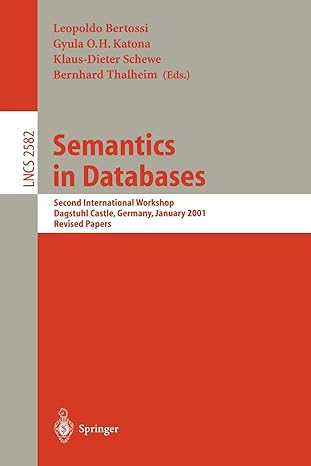Answered step by step
Verified Expert Solution
Question
1 Approved Answer
Identify the highest normal form to which the entity conforms ( 1 NF , 2 NF , 3 NF , BCNF , 4 NF ,
Identify the highest normal form to which the entity conforms NFNFNF BCNFNF or NF
Explain completely how the entity violates the next normal form unless it is in NF For example, if you state that the highest normal form to which a given entity conforms is NF then you must explain every violation of NF in the entity. Do not include poor design decisions that are not related to normalization there are a number of bad design choices that do not affect normalization.
Normalization Report Data Model
This data model depicts the creation and sale of beer by BeerCo. A batch of beer is created using a number of ingredients specified in a recipe for a specific product. A recipe is comprised of multiple different ingredients, and a record is kept for each ingredient in that recipe. Batches of beer can vary in size over time, thus requiring different amounts of the ingredients. Batches are created in set time periods there is a defined begin and end date for each batch. BeerCo. only makes a single batch of a given beer at a time. To try to get the product sold, the salesperson will advertise the beer in multiple size offerings cans bottles, kegs, etc. The current sales price is how much BeerCo is advertising that they will sell the product for. This price can change over time.
INGREDIENT a table for storing data on the ingredients used in making beer. BeerCo gets any specific ingredient from only one supplier.
PRODUCT a table for storing data on the beer products created by BeerCo.
RECIPE a table for storing data on which ingredients a specific beer uses in brewing.
BATCH a table for storing data on individual batches of beer.
SALESPERSON table for storing data on the salespeople that try to sell beer to stores.
CUSTOMER table for storing data on the stores that buy and sell beer and beer storage devices.
TRANSACTION table for storing data on which parties are associated with a beer salepurchase either as a buyer becoming the new owner of the beerbeer storage or a seller the original owner of the beerbeer storage. A specific instance of a beer itself can only have a single transaction, but beer storage can be bought and sold by both BeerCo. and the customers. Data on the sellers the original owners is necessary to create the listing.
INGREDIENT
Primary Key: IngredientID the identification number assigned to an ingredient instance ie ID could be for Hops, dry category, pounds, ID could be Hops, dry category, ounces, ID could be Hops, perishable, liters, etc.
Name the name of the ingredient.
Supplier the name of the supplier of the ingredient.
Classification the category of the ingredient wet dry, perishable, etc.
UnitofSize some ingredients are measured by the ounce, some by the pound, some by the liter, etc.
UnitPrice the cost of purchasing one unit of the ingredient.
RECIPE
Primary Key: RecipeID the identification number assigned to a recipe.
Primary Key & Foreign Key: IngredientID the identification number assigned to an ingredient used in this recipe.
Amount amount of the ingredient used in this recipe
BATCH
Primary Key & Foreign Key: BeerID the identification number assigned to a specific product.
Primary Key & Foreign Key: RecipeID the identification number assigned to the recipe for this batch.
Primary Key & Foreign Key: IngredientID the identification number assigned to an ingredient which the current recipe will use.
Primary Key: BatchBeginDate the date on which the batch of beer began brewing.
BatchEndDate the date on which the batch of beer stopped brewing.
AmountProduced the quantity of beer created by this recipe.
RecipeCost the total cost associated with brewing this batch of beer based on the ingredients.
PRODUCT
Primary KeyL BeerID the identification number assigned to a specific product.
Name the name of the beer.
Address the address street city, state, and ZIP code where this beer is always brewed
Size the amount of beer in a single package can bottle, pack, keg, etc.
Foreign Key: SPNumber the identification number assigned to the one and only salesperson responsible for selling this product.
CreatedDate the date on which the beer was first created.
OriginalSalesPrice the price that BeerCo. asked buyers to pay for the beer when it was first offered for sale.
CurrentSalesPrice the price that BeerCo. currently asks buyers to pay for the beer. While the asking price of the beer may change many times, only the original asking price and the most current asking price need to be retained by the system.
Storage? whether or not BeerCo. offers storage items for this product.
SALESPERSON
Primary Key: SPNumber an identification number assigned to a salesperson.
FirstName the first name of the salesperson.
LastName the surname or family name of the salesperson.
PhoneNumber the contact phone number for the salespe
Step by Step Solution
There are 3 Steps involved in it
Step: 1

Get Instant Access to Expert-Tailored Solutions
See step-by-step solutions with expert insights and AI powered tools for academic success
Step: 2

Step: 3

Ace Your Homework with AI
Get the answers you need in no time with our AI-driven, step-by-step assistance
Get Started


